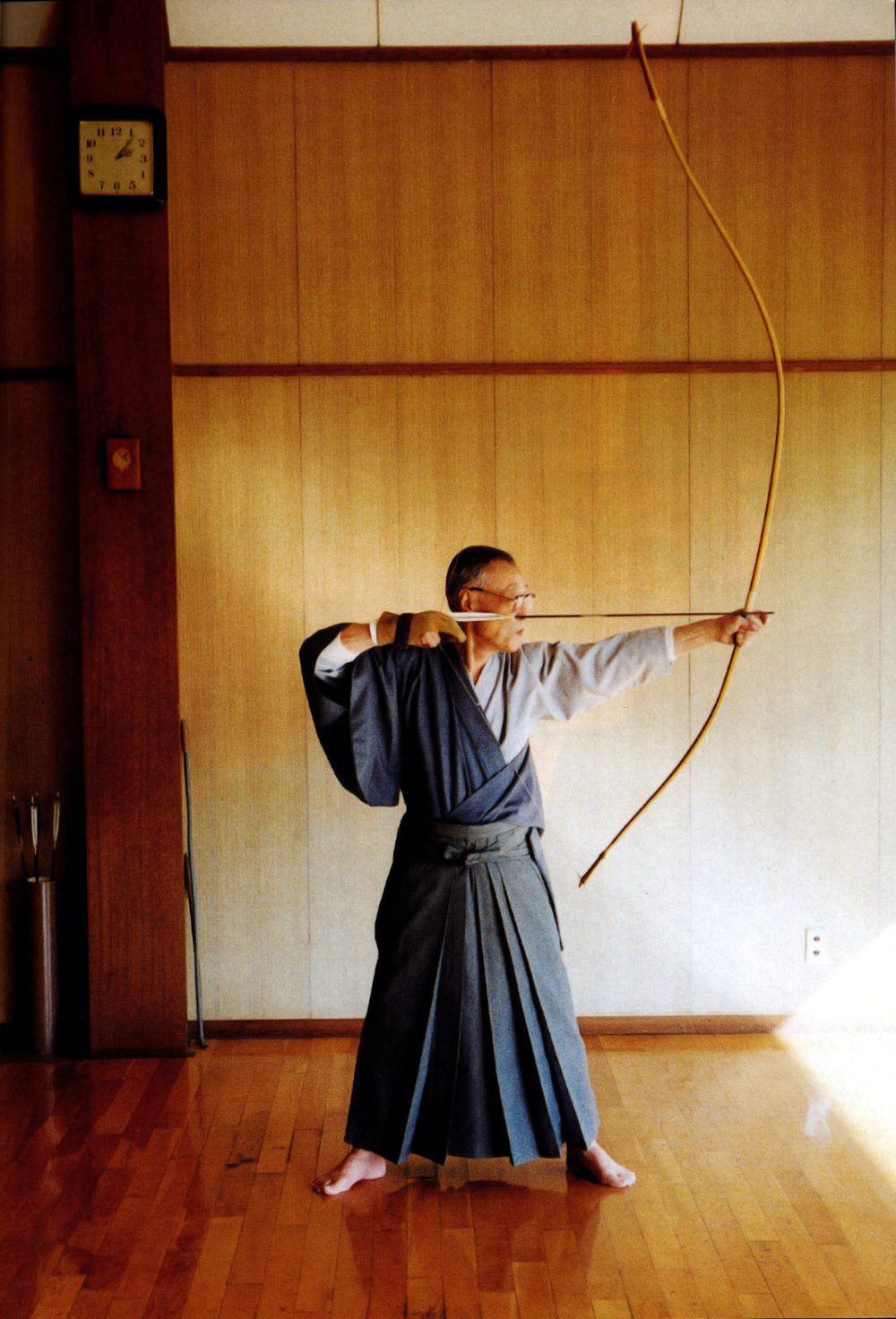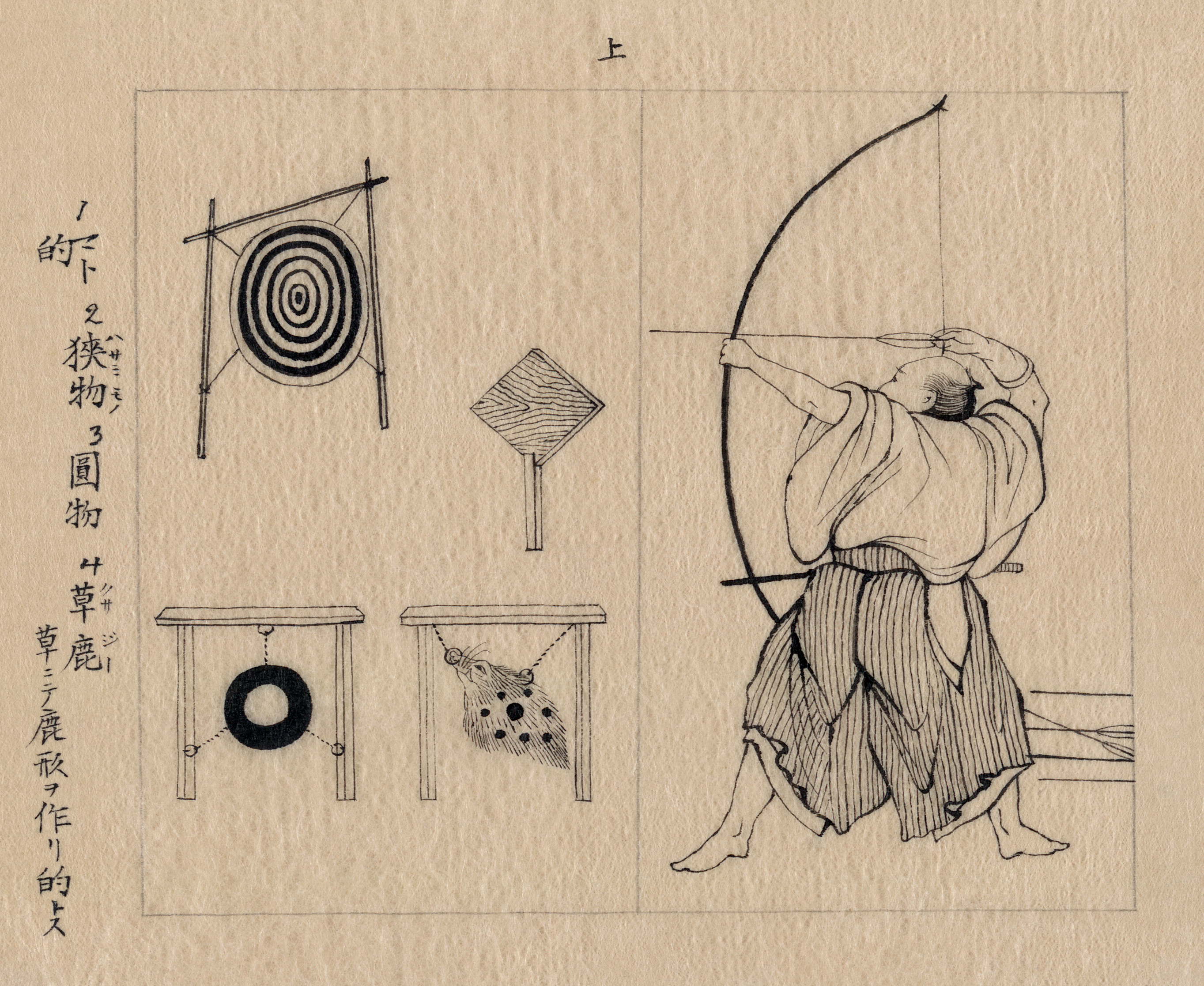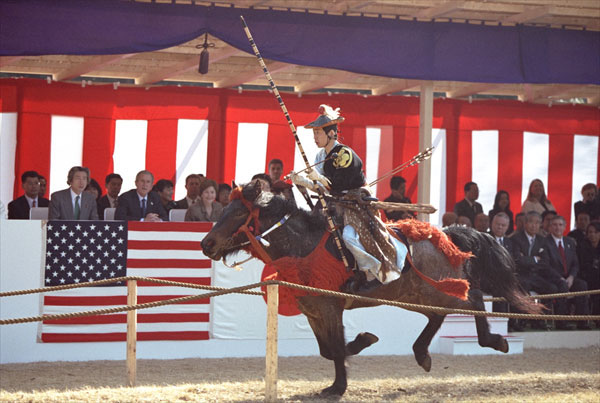|
Kyūdō
''Kyūdō'' ( ja, 弓道) is the Japanese martial art of archery. Kyūdō is based on '' kyūjutsu'' ("art of archery"), which originated with the samurai class of feudal Japan. In 1919, the name of kyūjutsu was officially changed to kyūdō, and following the example of other martial arts that have been systematizing for educational purposes, kyūdō also reorganized and integrated various forms of shooting that had been used up until then. High level experts in kyūdō may be referred to as , and some practitioners may refer to themselves as ''yumihiki'' (弓引き), or 'bow puller'. Kyūdō is practised by thousands of people worldwide. As of 2005, the International Kyudo Federation had 132,760 graded members. The bow they use is called a , and the most common one has an asymmetrical shape of more than , and is characterized by the archer holding the part of the bow below the center to shoot the arrow. History The beginning of archery in Japan is pre-historical. The first ... [...More Info...] [...Related Items...] OR: [Wikipedia] [Google] [Baidu] |
Archery
Archery is the sport, practice, or skill of using a bow to shoot arrows.Paterson ''Encyclopaedia of Archery'' p. 17 The word comes from the Latin ''arcus'', meaning bow. Historically, archery has been used for hunting and combat. In modern times, it is mainly a competitive sport and recreational activity. A person who practices archery is typically called an archer, bowman, or toxophilite. History Origins and ancient archery The oldest known evidence of the bow and arrow comes from South African sites such as Sibudu Cave, where the remains of bone and stone arrowheads have been found dating approximately 72,000 to 60,000 years ago.Backwell L, d'Errico F, Wadley L.(2008). Middle Stone Age bone tools from the Howiesons Poort layers, Sibudu Cave, South Africa. Journal of Archaeological Science, 35:1566–1580. Backwell L, Bradfield J, Carlson KJ, Jashashvili T, Wadley L, d'Errico F.(2018). The antiquity of bow-and-arrow technology: evidence from Middle Stone Age layers ... [...More Info...] [...Related Items...] OR: [Wikipedia] [Google] [Baidu] |
Kyūjutsu
("art of archery") is the traditional Japanese martial art of wielding a bow (yumi) as practiced by the samurai class of feudal Japan. Although the samurai are perhaps best known for their swordsmanship with a katana (''kenjutsu''), kyūjutsu was actually considered a more vital skill for a significant portion of Japanese history. During the majority of the Kamakura period through the Muromachi period (c.1185–c.1568), the bow was almost exclusively the symbol of the professional warrior, and way of life of the warrior was referred to as . History The beginning of archery in Japan is, as elsewhere, pre-historical. The first images picturing the distinct Japanese asymmetrical longbow are from the Yayoi period (ca. 500 BC–300 AD). The first written document describing Japanese archery is the Chinese chronicle ''Weishu'' (魏書; dated around 297 AD), which tells how in the Japanese isles people use "a wooden bow that is short from the bottom and long from the top."Yamada S ... [...More Info...] [...Related Items...] OR: [Wikipedia] [Google] [Baidu] |
Yabusame
is a type of mounted archery in traditional Japanese archery. An archer on a running horse shoots three special "turnip-headed" arrows successively at three wooden targets. This style of archery has its origins at the beginning of the Kamakura period. Minamoto no Yoritomo became alarmed at the lack of archery skills his samurai possessed. He organized yabusame as a form of practice. Nowadays, the best places to see yabusame performed are at the Tsurugaoka Hachiman-gū in Kamakura and Shimogamo Shrine in Kyoto (during Aoi Matsuri in early May). It is also performed in Samukawa and on the beach at Zushi, as well as other locations. History Japanese bows date back to prehistoric times – the Jōmon period. The long, unique asymmetrical bow style with the grip below the center emerged under the Yayoi culture (300 BC – 300 AD). Bows became the symbol of authority and power. The legendary first emperor of Japan, Emperor Jimmu, is always depicted carrying a bow. Some Emi ... [...More Info...] [...Related Items...] OR: [Wikipedia] [Google] [Baidu] |
Kasagake
Kasagake or Kasakake (笠懸, lit. "hat shooting") is a type of Japanese mounted archery. In contrast to yabusame, the types of targets are various and the archer shoots without stopping the horse. While yabusame has been played as a part of formal ceremonies, kasagake has developed as a game or practice of martial arts, focusing on technical elements of horse archery. History The word "kasagake" first appears in "Sadaie Assonn Ki" (定家朝臣記) by Minamoto no Sadaie in 1057 and "Shin Sarugō Ki" (新猿楽記) by Fujiwara no Akihira (989-1066)Murai, 1939 while legendary sayings states kasagake has been started by Minamoto no Yoritomo (1147-1199). At first, hats (ayaigasa) hung on azuchi were used as targets, later replaced by target specially made for kasagake, consists of wooden skeleton, cotton, wool or rice straws stuffing and leather surface, hung on wooden frames as in the picture above. In Kamakura period, "the three martial arts of mounted archery" (騎射三� ... [...More Info...] [...Related Items...] OR: [Wikipedia] [Google] [Baidu] |
Yumi
is the Japanese term for a bow. As used in English, refers more specifically to traditional Japanese asymmetrical bows, and includes the longer and the shorter used in the practice of and , or Japanese archery. The was an important weapon of the samurai warrior during the feudal period of Japan. It is typically shot with Japanese arrows known as . The most famous style of is an asymmetrically shaped long bow with a length of more than , characterized by the archer holding the part of the bow below the center to shoot the arrow. History Most of the excavated Jōmon period () bows are in length, while most of the Yayoi period () bows are in length. The bows in these periods were made from a single processed wood, and the bows with this structure were called and were used until the Nara period (710–794 CE). It is unknown when the asymmetrical came into use, but the first written record is found in the ''Book of Wei'', a Chinese historical manuscript dating to the 3 ... [...More Info...] [...Related Items...] OR: [Wikipedia] [Google] [Baidu] |
:Category:Japanese Words And Phrases ...
{{Commons Words and phrases by language Words Words Words A word is a basic element of language that carries an objective or practical meaning, can be used on its own, and is uninterruptible. Despite the fact that language speakers often have an intuitive grasp of what a word is, there is no consen ... [...More Info...] [...Related Items...] OR: [Wikipedia] [Google] [Baidu] |
Kamakura Shogunate
The was the feudal military government of Japan during the Kamakura period from 1185 to 1333. Nussbaum, Louis-Frédéric. (2005)"''Kamakura-jidai''"in ''Japan Encyclopedia'', p. 459. The Kamakura shogunate was established by Minamoto no Yoritomo after victory in the Genpei War and appointing himself as ''shōgun''. Yoritomo governed Japan as military dictator from the eastern city of Kamakura with the emperor of Japan and his Imperial Court in the official capital city of Heian-kyō (Kyoto) as figureheads. The Kamakura ''shōguns'' were members of the Minamoto clan until 1226, the Fujiwara clan until 1252, and the last six were minor princes of the imperial family.Nussbaum"Minamoto"at pp. 632–633. The Hōjō clan were the ''de facto'' rulers of Japan as ''shikken'' (regent) of the ''shōgun'' from 1203.Nussbaum"Fujiwara"at pp. 200–201. The Kamakura shogunate saw the Jōkyū War in 1221 and the Mongol invasions of Japan under Kublai Khan in 1274 and 1281. The Kamaku ... [...More Info...] [...Related Items...] OR: [Wikipedia] [Google] [Baidu] |
Mounted Archery
A horse archer is a cavalryman armed with a bow and able to shoot while riding from horseback. Archery has occasionally been used from the backs of other riding animals. In large open areas, it was a highly successful technique for hunting, for protecting the herds, and for war. It was a defining characteristic of the Eurasian nomads during antiquity and the medieval period, as well as the Iranian peoples, (Alans, Scythians, Sarmatians, Parthians, Sassanid Persians) and Indians in antiquity, and by the Hungarians, Mongols, Chinese, and the Turkic peoples during the Middle Ages. By the expansion of these peoples, the practice also spread to Eastern Europe (via the Sarmatians and the Huns), Mesopotamia, and East Asia. In East Asia, horse archery came to be particularly honored in the samurai tradition of Japan, where horse archery is called Yabusame. The term mounted archer occurs in medieval English sources to describe a soldier who rode to battle but who dismounted to shoot. ' ... [...More Info...] [...Related Items...] OR: [Wikipedia] [Google] [Baidu] |
Inuoumono
was a Japanese sport that involved mounted archers shooting at dogs. The dogs were released into a circular enclosure approximately 15m across, and mounted archers would fire upon them whilst riding around the perimeter. Originally intended as a military training exercise, dog-shooting became popular as a sport among the Japanese nobility during the Kamakura and Muromachi periods (1185-1573). During this time it was briefly banned during the rule of Emperor Go-Daigo (owing to his concern for the dogs); however, this ruling was overturned by the shōgun Ashikaga Takauji at the behest of his archery teacher Ogasawara Sadamune. The influential Ogasawara family were particular adherents of inuoumono; Sadamune's archery treatise ''Inuoumono mikuanbumi'' regarded it as fundamental to a warrior's training, and his great-grandson Mochinaga devoted five books to the subject. The arrows used in dog-shooting were usually rendered non-fatal, by being either padded or blunted. This modificati ... [...More Info...] [...Related Items...] OR: [Wikipedia] [Google] [Baidu] |
Sengoku Period
The was a period in History of Japan, Japanese history of near-constant civil war and social upheaval from 1467 to 1615. The Sengoku period was initiated by the Ōnin War in 1467 which collapsed the Feudalism, feudal system of Japan under the Ashikaga shogunate. Various samurai warlords and Japanese clans, clans fought for control over Japan in the power vacuum, while the emerged to fight against samurai rule. The Nanban trade, arrival of Europeans in 1543 introduced the arquebus into Japanese warfare, and Japan ended its status as a Tributary system of China, tributary state of China in 1549. Oda Nobunaga dissolved the Ashikaga shogunate in 1573 and launched a war of political unification by force, including the Ishiyama Hongan-ji War, until his death in the Honnō-ji Incident in 1582. Nobunaga's successor Toyotomi Hideyoshi completed his campaign to unify Japan and consolidated his rule with numerous influential reforms. Hideyoshi launched the Japanese invasions of Korea (159 ... [...More Info...] [...Related Items...] OR: [Wikipedia] [Google] [Baidu] |
Heki Danjō Masatsugu
was a warrior and the creator of the school of basic archery skills for footsoldiers. Heki Danjō's teaching started one of the prominent schools of ''kyūdō'', which is named '' Heki-ryū'' after him. Several ''Heki-ryū'' branches are taught actively even today. Heki Danjō lived in warlike times when it was considered honorable to be linked to famous warriors. For this reason there is no certainty to the connection between every Heki-ryū branch and the historical figure Heki Danjō. It is known however that Heki Danjō taught Yoshida Shigekata, who compiled the lessons in a scroll (''mokuroku''), which is still an important part of Heki-ryū's teaching. The founder of ''Heki-ryū'' ''Insai''-branch, Yoshida Genpachirō Shigeuji, wrote about Heki Danjō as a manifestation of the god of war Hachiman In Japanese religion, ''Yahata'' (八幡神, ancient Shinto pronunciation) formerly in Shinto and later commonly known as Hachiman (八幡神, Japanese Buddhist pronunciation) is ... [...More Info...] [...Related Items...] OR: [Wikipedia] [Google] [Baidu] |








